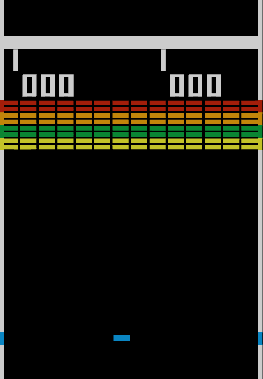Breakout¶
Breakout is an arcade game developed and published by Atari and released in 1976.
Breakout begins with eight rows of bricks, with each two rows a different color. The color order from the bottom up is - yellow, - green, - orange and - red.
Using a single ball, the player must knock down as many bricks as possible by using the walls and/or the paddle below to ricochet the ball against the bricks and eliminate them.
If the player’s paddle misses the ball’s rebound, they will lose a turn. The player has three turns to try to clear two screens of bricks. Yellow bricks earn one point each, green bricks earn three points, orange bricks earn five points and the top-level red bricks score seven points each. The paddle shrinks to one-half its size after the ball has broken through the red row and hit the upper wall.
Ball speed increases at specific intervals: after four hits, after twelve hits, and after making contact with the orange and red rows. The highest score achievable for one player is 896; this is done by eliminating two screens of bricks worth 448 points per screen.

Making an app¶
The first step is to create a frame work which creates a window

from pygame.locals import *
import numpy as np
class Sprite:
def __init__(self, file=None, pos=(0, 0), size=None):
self.parent = None
self.size = size
self.rect = Rect(pos, (20, 20))
self.position = np.array(pos, dtype=float)
self.velocity = np.array([1.5, 0.5], dtype=float)
self.angle = 0
self.angular_velocity = 0
self.color = 'red'
self.speed = [0, 0]
if file:
self.image = pygame.image.load(file)
if self.size:
self.image = pygame.transform.scale(self.image, size)
self.rect.size = self.image.get_size()
else:
self.image = pygame.Surface(self.rect.size)
self.image.fill(self.color)
self.image0 = self.image.copy()
def set_pos(self, pos):
self.position = np.array(pos, dtype=float)
self.rect.center = pos
def set_angle(self, angle):
self.angle = angle
self.image = pygame.transform.rotate(self.image0, self.angle)
self.rect.size = self.image.get_size()
def do(self, event):
pass
def update(self):
self.move()
def move(self):
self.position += self.velocity
if self.angular_velocity:
self.angle += self.angular_velocity
self.image = pygame.transform.rotate(self.image0, self.angle)
self.rect.size = self.image.get_size()
self.rect.center = self.position
def draw(self, surf):
surf.blit(self.image, self.rect)
def distance(self, other):
distance = self.position - other.position
distance *= distance
d = np.sqrt(np.sum(distance))
return d
class App:
def __init__(self, file=None, caption='Pygame'):
pygame.init()
pygame.display.set_caption(caption)
self.flags = RESIZABLE
self.size = (640, 240)
self.screen = pygame.display.set_mode(self.size, self.flags)
self.running = True
self.updating = True
self.objects = []
self.bg_color = 'gray'
if file:
self.load_image(file)
else:
self.image = pygame.Surface(self.size)
self.image.fill(self.bg_color)
self.rect = self.image.get_rect()
self.key_cmd = {}
def load_image(self, file):
self.image = pygame.image.load(file).convert()
self.rect = self.image.get_rect()
self.screen = pygame.display.set_mode(self.rect.size, self.flags)
def run(self):
while self.running:
for event in pygame.event.get():
self.do(event)
self.update()
self.draw()
def add_cmd(self, key, cmd):
self.key_cmd[key] = cmd
print(self.key_cmd)
def add(self, object):
self.objects.append(object)
object.parent = self
def do(self, event):
if event.type == QUIT:
self.running = False
pygame.quit()
elif event.type == KEYDOWN:
if event.key == K_SPACE:
self.updating = not self.updating
if event.key in self.key_cmd:
cmd = self.key_cmd[event.key]
eval(cmd)
for obj in self.objects:
obj.do(event)
def update(self):
if self.updating:
for obj in self.objects:
obj.update()
def draw(self):
self.screen.blit(self.image, self.rect)
for obj in self.objects:
obj.draw(self.screen)
pygame.display.update()
if __name__ == '__main__':
app = App('space.png', 'Asteroids')
ship = Sprite('spaceship.png', size=(100, 50), pos=(300, 200))
app.add(ship)
app.add(Sprite('asteroid.png', size=(100, 100), pos=(100, 300)))
app.add(Sprite('asteroid.png', size=(150, 150), pos=(400, 100)))
app.add_cmd(K_a, 'print(123)')
app.add_cmd(K_b, "self.load_image('space.png')")
app.run()